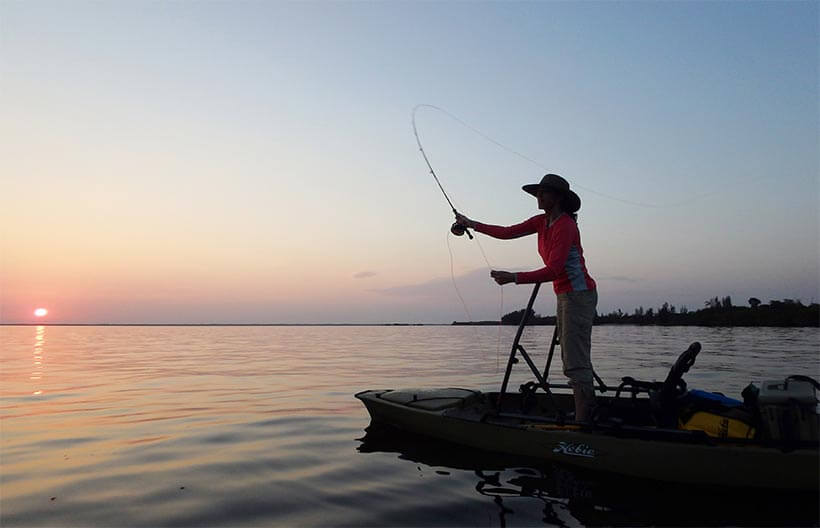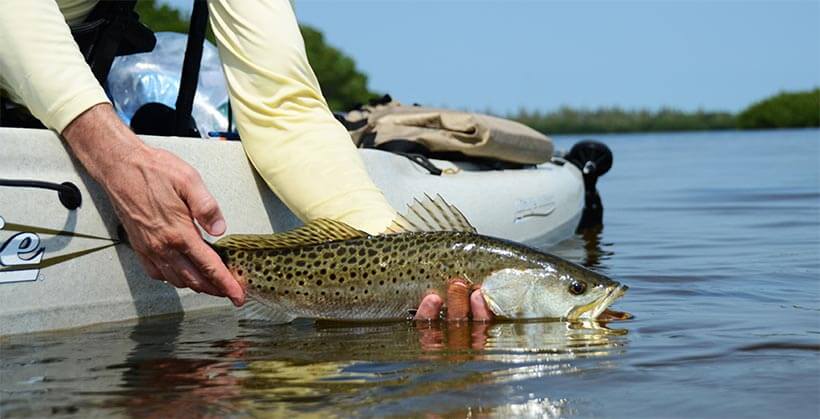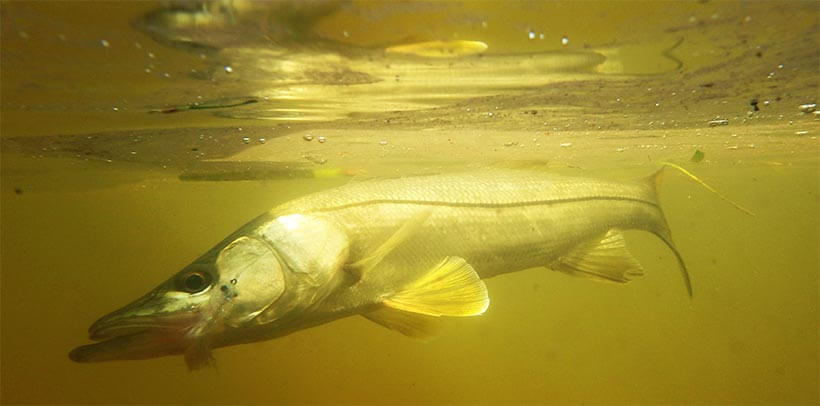MY HUSBAND, JACK, desperately wanted to hook a big snook, which was the motivation behind our three-night DIY kayak-fishing trip around Pine Island, the largest landmass in the archipelago which includes southwest Florida’s seaside resorts of Sanibel and Captiva. There was only one problem, as far as we knew an inn-to-inn paddle-trip in that area had never been done before. It wasn’t exactly a heroic off-the-grid adventure. During the day we’d weave in and out of mangroves and across shallow bays, then come ashore at dinnertime, check in to a waterfront lodge, then paddle and fish again the next day.
“I think it’ll work,” Jack said, after researching some nautical charts and regional websites. “We’ll need to paddle about eight miles each day, which should leave us plenty of time to fish.”
Eight miles in the ocean? What if we got lost? What if the sun scorched our pale northern hides? But we might catch snook! A month later, we launched our boats at Tarpon Lodge on the west side of Pine Island.
Built in 1926, Tarpon Lodge is an elegant, historic fishing retreat with a gourmet restaurant, sweeping palm-framed lawns, and world-class waterfront sunsets. It’s also located on the Great Calusa Blueway, a 190-mile canoe and kayak “trail” that winds among mangrove islands, coastal estuaries, and river-like waterways. Our route would follow a portion of the Blueway, whose periodic markers gave me a modicum of directional comfort.
Day 1: Tarpon Lodge to Beachouse Lodge
We cast off at pre-dawn, heading north, hugging the shoreline. After paddling steadily for an hour, an orange glow crept over the horizon then spilled across water. Jack and I took advantage of the first tendrils of light, casting across several submerged sandbars. All was quiet except for the lapping water against our kayaks and the whishing of our lines sailing over the ginger-hued water.
“Got one!” Jack yelled, netting a 14-inch spotted seatrout, with golden eyes and black spots extending over its back and up its dorsal fin. Its flanks shimmered iridescent copper, reflecting the color from the fleeting sunrise. But it wasn’t a snook.
Next, we worked our way north among the mangrove islands, reeling in a redfish, a ladyfish, and a couple more seatrout. By late morning, a marker for the Calusa Blueway pointed the way into Jug Creek, which opened into Back Bay on the northern tip of Pine Island. We paddled over to a deserted houseboat and began casting again. Another seatrout came quickly to Jack’s net, then the ladyfish found us. One after another… after another.
From the bay, we continued into another channel that led under a bridge and past a marina. Finally we emerged in the expansive Charlotte Harbor. By then it was midafternoon and a sweltering 92 degrees (F). Burned out from a full day in the sun, I had just enough energy to make it to our destination at Beachouse Lodge.
Day 2: Beachouse Lodge to Matlacha Cottages
An angler could park a kayak at Beachouse Lodge and then reel in redfish, tarpon, or snook without paddling a stroke. The lodge’s 260-foot private fishing pier shades swarms of baitfish that draw in the big fellas. Jack immediately planted himself at the end of the dock and then cast and cast until his arm and shoulder went numb. We were still in the hunt for a trophy snook.
He finally quit, snook-less, when the night became so inky he could no longer sense where his line landed on the water.
The next morning we launched our kayaks in the pre-dawn. Barely a ripple creased the calm water, allowing us to make good time toward Smokehouse Bay, a long shallow stretch of water sheltered by a string of dense mangrove islands. Big fish supposedly lurk in the cuts.
Jack headed toward several cormorants drying their wings on a driftwood snag. He anchored his kayak, then waded through the foot-deep water, throwing his line here and there. His shotgun strategy rewarded him with several more seatrout.
We paddled on, sometimes casting, sometimes trolling, eventually coming to a larger bay known as Indian Field. At the top of Indian Field, mullet schools were thick around the mangroves. Jack paused, holding a schminnow in one hand and his rod in the other, watching as the water rippled arrhythmically about 30 yards in front of him. With a quick, assertive flick, he tossed the schminnow precisely into the spot.
A silver fish with a distinct black lateral line and protruding lower jaw pounced on his fly. A tense tug-o-war commenced. A few minutes later, Jack had his snook, well, a snook. It wasn’t a 20-pounder.
Later that afternoon as we relaxed on the small pier at our final destination, Matlacha Cottages, the owner sat down beside us.
“In the last 48 hours, I’ve seen two tarpon and a redfish off the dock here,” he said. “The ponds in this estuary are filled with them.”
“How about snook?” Jack asked.
“Where there are redfish, there are usually snook this time of the year,” our host replied.
“There’s still a couple hours of daylight,” Jack said, excusing himself and heading to his kayak. “Don’t make our dinner reservation until after dark.”
This article original appeared in the July 2017 Newsletter of DIY Fishing: DIYFishing.com





